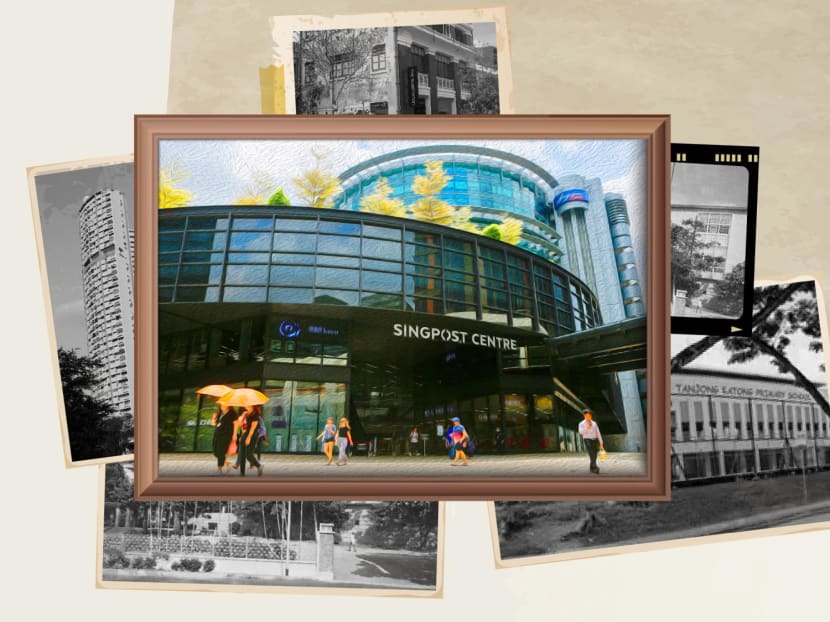As older buildings are sacrificed in the pursuit of progress, Singaporeans lose part of what makes us who we are
Commentary: As older buildings are sacrificed in the pursuit of progress, Singaporeans lose part of what makes us who we are

A favourite place of the author's was the original Singapore Post Centre, which opened in Paya Lebar in 1998 and made way for its current iteration in 2017 — a lifespan of just 19 years.
In Facebook groups dedicated to sharing memories of growing up in Singapore, a photo from the late 2000s resurfaces a few times each year, eliciting a wave of nostalgia in me every time.
It is taken from inside the noodles stall at the old Tanjong Katong Primary School canteen. The two children pictured buying food at the counter were my classmates at the time.
I have a lot of fond memories of that stall and that canteen. Back then, you could get a bowl of fishball noodle soup for 60 cents. It consisted of the most alkaline-tasting yellow noodles soaked in an MSG-laden broth — absolutely delicious during those simpler times.
We would buy our food from stalls decorated with cute awnings — the kind you might find in a French marketplace. Then we would tuck in at round silver-coloured tables surrounded by metal chairs wrapped in coloured plastic wires. The founding principal of the school, Mr Bucktha Seelan, always referred to the canteen as the café, and his interior design for the space clearly reflected that vision.

That canteen no longer exists. Neither do many of my favourite parts of the old school grounds. No more welcoming entrance, heavily vegetated with the plants and ponds that Mr Seelan loved so much. No more banana trees randomly dotted around the perimeter fence. No more open-air play areas where I spent hours messing around with my friends until my legs were sunburned red as lobsters.
The entire premises were demolished in 2018 and rebuilt — just 17 years after the school first opened.
From the outside, the main building is now a rectangular concrete slab. Where the football field and basketball court used to be, there is now a massive structure for indoor sports — another concrete slab.
Tanjong Katong Primary School still stands on the same spot today on Haig Road, but save for a handful of throwback photos on the Ministry of Education Heritage Centre website, the school that I attended exists only in the collective memories of me and my contemporaries who studied and worked at the original Tanjong Katong Primary.
THE PRICE WE PAY FOR MODERNITY
When we think about the loss of heritage buildings, we often envision a bunch of elderly folk reminiscing wistfully about places they used to frequent as children, half a century ago or more. My father loves talking about his primary school, Dorset Primary School in Farrer Park, which literally no longer exists, having closed down in 1981.
Indeed, in other countries, reminiscing about places long gone may more exclusively be the domain of older generations. In Europe, for example, it is not uncommon to come across buildings that have been around since World War II and before, even in rapidly developing cities.
But in Singapore, we are sometimes victims of our own relentless pursuits of progress. I myself have a keen sense of loss for many places that served as the backdrop to my formative, growing-up years, most of which have transformed beyond recognition by now. Should this be the norm for a young person still only in their mid-twenties?
Another favourite place of mine was the original Singapore Post Centre, which opened in Paya Lebar in 1998 and made way for its current iteration in 2017 — a lifespan of just 19 years.
My parents and I used to do our weekly grocery shopping at the NTUC FairPrice there every weekend. It was also where I had my first pair of spectacles made — and later, when I was old enough to assert my preference for frameless glasses, my second pair too. Both were made at the old Kai Joo Optics, which has since renamed to KJ Optometrists and expanded to several outlets island-wide.

The current SingPost Centre has both NTUC FairPrice and KJ Optometrists and more. What it does lack, however, is the flavour of the original — the strange odours and mysterious puddles in the basement car park, the excruciatingly slow hydraulic elevators, and the overall dinginess about the place. Those were the things that set Singapore Post Centre apart from the typical sterile neighbourhood mall of our current times.
I never thought they were special back then, but I find myself missing them now that they are gone.
The list goes on — the Sentosa monorail, and the island as a whole before the construction of the integrated resorts, is an example that many Singaporeans will likely relate to.
COUNTING THE COST
It’s not just about the loss of heritage and culture from the eradication of these historic establishments, nor the collective sense of sadness or even sorrow this brings to the people for whom memories will remain the only record of their existence.
This practice of rebuilding structures which are no longer “new” but still a far cry from “old” — especially if they remain perfectly functional and operational — is also hugely wasteful, from both a financial standpoint as well as an environmental sustainability one.
Staggering amounts of money, materials, and labour are expended on the construction of any large building. Construction activities of this scale also cause environmental damage such as air, noise, and water pollution.
To make this a worthwhile endeavour, we should maximise the utility of such buildings by occupying them for as long as possible. It makes little sense to spend even more money to tear down and redevelop something after not even two decades have passed.
Even as we strive for constant improvement in our living spaces, it would benefit us to pause our never-ending quest for progress to reconsider if we are happy to pay the costs — tangible and otherwise — and if they truly are outweighed by the perceived benefits.
Physical locations serve as anchors for communities. They are concrete touchstones around which we organise ourselves and our lives: People may not remember the specific types of household items and products they used to buy, but they remember where they did their routine everyday shopping. People may not always remember what food they ate from day to day, but they remember where they ate workday lunches and after-school dinners on most days, and the places where they often met up with their friends.
This sense of community can be (and often is) passed down through generations — many parents, for example, love introducing their children to their favourite haunts.
Should we remain on this trajectory of relentless redevelopment, we will lose the ability to show the next generation of young Singaporeans the places which helped to shape us and define us in our own youth, simply because they got renovated into some shiny but generic, bland concoction of concrete, glass, and steel — just another among the thousands of others on our little island. Now, wouldn’t that be a massive shame?
ABOUT THE AUTHOR:
Jonathan Tiong works in corporate communications and employee engagement. He has spinal muscular atrophy (Type 2). As an advocate for disability inclusion in corporate employment, Jonathan has shared his views and advice in interviews and panel discussions.
This article was originally published on TODAY. Its inclusion on this website is solely for education purposes.